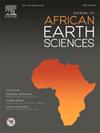阿拉伯-努比亚地盾花岗岩矿物化学、ASTER热液蚀变填图及岩土工程特征以埃及东南部沙漠Wadi El-Hima为例
IF 2.2
4区 地球科学
Q2 GEOSCIENCES, MULTIDISCIPLINARY
引用次数: 0
摘要
在对Wadi El-Hima花岗岩的研究中,我们介绍了岩石学、全岩化学和矿物化学(显微探针)表征的结果;ASTER热液蚀变填图;以及物理力学(岩土)特性,包括使用这些花岗岩的尺寸和装饰石的适用性。我们的地质岩石学结果表明,Wadi El-Hima包含4种类型的花岗岩,大致分为同一时期的花岗岩套件:较老的花岗闪长岩和闪长岩套件,较年轻的正长花岗岩和碱长石二云母花岗岩套件。尽管相对年龄不同,但除了碱性长石花岗岩的亲和度从铝质到过碱性,所有相都表现出高钾钙碱性到弱过铝质特征。特隆杰米花岗岩是一种罕见的富三稀土过铝质花岗岩,在全球花岗岩中占3%。较老的花岗闪长岩-长闪长岩套最接近于火山弧花岗岩,特别是i - s型花岗岩,而较年轻的正长花岗岩-碱长石-二云母花岗岩套则倾向于板内花岗岩和a型花岗岩。利用ASTER相对波段深度、波段比值和矿物指标对热液蚀变进行遥感测图,结果表明绿帘石、绿泥石、碳酸盐和绢云母为主要蚀变相,高岭石和氧化铁为次要相。物理力学试验结果表明,其容重范围为2.56 g/cm3(正长花岗岩)~ 2.72 g/cm3(花岗闪长岩)。吸水率从0.15%(长石花岗岩)到0.22%(碱长石花岗岩)不等。单轴抗压强度范围从50.9(花岗闪长岩)到141 MPa(长闪长岩)。所有花岗岩的断裂模量和抗弯强度范围相似,分别为3.8 ~ 10.8 MPa和3.2 ~ 8.9 MPa。四种岩石均通过了ASTM C20和ASTM c97试验的最小物理要求(容重、吸水率、表观孔隙率),但由于力学缺陷,未能通过ASTM C170、ASTM c99、ASTM c880和ASTM c615试验的最小力学要求(单轴抗压强度、破裂模量和抗弯强度)。因此,Wadi El-Hima花岗岩对承重建筑应用的适用性较低,但对非承重装饰应用(如台面和洗手盆)的适用性中等至高度。本文反映了全球在描述花岗岩作为尺寸和装饰石的适用性方面所做的努力,并将这些发现与石化和遥感结果联系起来。本文章由计算机程序翻译,如有差异,请以英文原文为准。
Mineral chemistry, ASTER hydrothermal alteration mapping, and geotechnical characterization of granitic rocks of the Arabian-Nubian Shield; A case study from Wadi El-Hima, South Eastern Desert, Egypt
In this study of Wadi El-Hima granites, we present the results of petrographic, whole-rock chemistry, and mineral chemistry (microprobe) characterization; hydrothermal alteration mapping using ASTER data; and physico-mechanical (geotechnical) characterization, including suitability of using these granites for dimension and decorative stone. Our geological and petrographical results indicate that Wadi El-Hima contains four types of granitoids, divided into approximately coeval suites: an older granodiorite and trondhjemite suite, and a younger syenogranite and alkali feldspar two-mica granite suite. Despite the difference in relative ages, all phases exhibit high-K calc-alkaline to weakly peraluminous signatures except for alkali feldspar granite that ranges in affinity from metaluminous to peralkaline. Trondhjemite is an unusual HREE-enriched peraluminous granitoid placing it into a novel category comprising <3 % of global granitoids. The tectonic origin of the older granodiorite-trondhjemite suite most closely resembles volcanic arc granite, in particular, I-S-type granite, whereas the younger syenogranite-alkali feldspar two-mica granite suite trends toward within-plate granite and A-type granite. Remote sensing mapping of hydrothermal alteration using ASTER relative band depth, band ratio, and mineral indices indicate that epidote, chlorite, carbonate, and sericite comprise the predominant alteration phases, whereas kaolinite and iron oxides comprise minor phases. Physico-mechanical test results show that bulk density ranges from 2.56 g/cm3 (syenogranite) to 2.72 g/cm3 (granodiorite). Water absorption ranges from 0.15 % (trondhjemite) to 0.22 % (alkali feldspar granite). Uniaxial Compressive Strength ranges from 50.9 (granodiorite) to 141 MPa (trondhjemite). The modulus of rupture and flexural strength of all the granites have similar ranges of 3.8–10.8 MPa and 3.2–8.9 MPa, respectively. All four rock types passed the minimum physical requirements (bulk density, water absorption, apparent porosity) of ASTM C20 and 97 tests, but, owing to mechanical flaws, failed the minimum mechanical requirements (Uniaxial Compressive Strength, Modulus of Rupture, and Flexural Strength) of ASTM C170, 99, 880, and 615 tests. Accordingly, Wadi El-Hima granitic rocks have low suitability for load-bearing construction applications but moderate to high suitability for non-load-bearing decorative applications, such as countertops and wash basins. This paper reflects global efforts to characterize the suitability of granites for use as dimension and decorative stone and to link such findings to petrochemical and remote sensing results.
求助全文
通过发布文献求助,成功后即可免费获取论文全文。
去求助
来源期刊

Journal of African Earth Sciences
地学-地球科学综合
CiteScore
4.70
自引率
4.30%
发文量
240
审稿时长
12 months
期刊介绍:
The Journal of African Earth Sciences sees itself as the prime geological journal for all aspects of the Earth Sciences about the African plate. Papers dealing with peripheral areas are welcome if they demonstrate a tight link with Africa.
The Journal publishes high quality, peer-reviewed scientific papers. It is devoted primarily to research papers but short communications relating to new developments of broad interest, reviews and book reviews will also be considered. Papers must have international appeal and should present work of more regional than local significance and dealing with well identified and justified scientific questions. Specialised technical papers, analytical or exploration reports must be avoided. Papers on applied geology should preferably be linked to such core disciplines and must be addressed to a more general geoscientific audience.
 求助内容:
求助内容: 应助结果提醒方式:
应助结果提醒方式:


